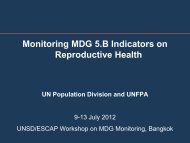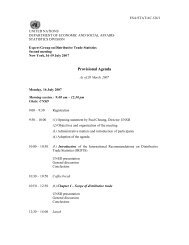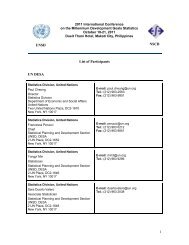demographic yearbook annuaire demographique 1951
demographic yearbook annuaire demographique 1951
demographic yearbook annuaire demographique 1951
You also want an ePaper? Increase the reach of your titles
YUMPU automatically turns print PDFs into web optimized ePapers that Google loves.
mortality rates for 119 areas for the period 1930 to 1950.<br />
The rate is the number of deaths under 1 year of age reported<br />
for each calendar year per 1,000 live births reported for<br />
the same year. Infant mortality rates are computed with<br />
reference to live births instead of to the midyear population<br />
under 1 year of age because the number of births is a<br />
better measure of the population that is exposed to the<br />
possibility of dying during a given year at ages of less<br />
than 1 year.<br />
In the computation of the infant mortality rates shown, no<br />
adjustment was made to take account of the fact that some<br />
of the deaths during a given year are deaths of infants who<br />
were born during the preceding year. The rates are based<br />
on the births which occurred in the same calendar year as<br />
the deaths. However, unless birth numbers or infant death<br />
rates are changing rapidly, the error involved is not<br />
important.<br />
In countries where statistics refer to events registered,<br />
irrespective of date of occurrence and where registration<br />
procedures are irregular, drastic fluctuations in the number<br />
of births registered may introduce sizable errors into the<br />
infant mortality rates, especially if deaths tend to be more<br />
promptly reported than births. If the lag in registration<br />
remains nearly constant and is approximately the same for<br />
births and deaths, the rates are not affected to any appreciable<br />
degree by this factor.<br />
Underregistration of births and infant deaths also affects<br />
the rates unless the proportion registered is the same for<br />
both components. Differences in the proportion registered<br />
will bias the rates upward or downward, the direction of<br />
the bias depending on which component is more fully registered.<br />
The omission of equal numbers of births and deaths,<br />
which occurs when deaths of infants whose birth was<br />
unregistered are excluded from the death statistics, gives<br />
the rates a downward bias.<br />
Statistics of infant deaths classified by subdivisions of the<br />
first year of life and by sex are presented in table 20 (69<br />
areas) and table 21 (68 areas) for the period 1936 to 1950.<br />
These data are useful in the analysis of mortality because<br />
the probability of dying changes markedly during the first<br />
year of life, being considerably higher at the beginning of<br />
the year and decreasing rapidly thereafter.<br />
Table 20 gives annual numbers for each sex but not for<br />
the two sexes combined. Deaths of unstated sex are therefore<br />
excluded and the implied totals in some cases disagree slightly<br />
with those shown in table 18. As for the previous tables,<br />
discrepancies are noted unless they are very small.<br />
Methods of reckoning the age of infants at the time of<br />
death vary. This is an important consideration with respect<br />
to age intervals up to one week. In general, the age at death<br />
is determined on the basis of the time elapsed after birth<br />
(hours, minutes, days, as appropriate) and is expressed in<br />
completed units of time. In some cases, however, the age is<br />
expressed to the nearest day or is based on calendar days,<br />
the calendar day of birth being counted as the first day of<br />
life and infants dying the day after birth being classified as<br />
1 day of age even though they may have died less than 24<br />
hours after birth. Age classifications known to be expressed<br />
in other than completed units of time, reckoned from the<br />
exact time of birth, are noted in the table. This factor is<br />
disregarded for age intervals of one month or over.<br />
Table 21 gives annual rates for each sex and for the two<br />
sexes combined. The rate is the number of deaths of the<br />
given age and sex per 1,000 live births of the same sex.<br />
Thus, the base of each age-specific rate is the same as that<br />
of the rate for all deaths under 1 of the same sex. The rates<br />
are therefore additive by age but not by sex. The total<br />
rate (for both sexes combined) shown in the first column<br />
of the table is the conventional infant mortality rate that<br />
appears also in table 19, infant deaths for which the sex or<br />
the exact age is unstated being included in the computation.<br />
Table 22 and table 23 present statistics of causes of death.<br />
Table 22 gives for 51 areas the number of deaths from each<br />
cause and corresponding cause-specific rate (deaths from<br />
each cause per 100,000 persons in the total population) for<br />
the years 1947 to 1949. Deaths classified by cause, age and<br />
sex for 27 areas are given for a recent year (1947, 1948 or<br />
1949) in table 23. In both tables the classification by cause<br />
is according to the abridged list of the Fifth (1938) Revision<br />
of the International List of Causes of Death. A discussion<br />
of cause-of-death statistics and of the problems involved in<br />
their interpretation is given in Chapter II.<br />
In the compilation of these tables available data for some<br />
of the areas have not been included. Where the number of<br />
deaths was less than 1,000, in the case of table 22, or 5,000,<br />
in the case of table 23, the data have been omitted because<br />
of the smallness of the numbers for individual causes and<br />
age groups. Even among the data presented in the tabies,<br />
some of the frequencies are very small and the accompanying<br />
rates are of little value.<br />
Where the data shown are limited in their coverage the<br />
pattern of the cause distribution should not be taken as<br />
indicative of that for the area as a whole. Particular care<br />
should be taken in interpreting data where a high proportion<br />
of deaths is recorded as due to senility or to unknown,<br />
ill-defined or unspecified causes. The relative magnitude of<br />
this group for the areas appearing in table 22 is given in<br />
Table 0 of Chapter II.<br />
The age groups shown in table 23 are as follows: under<br />
1 year, 1-4, 5-14, 15-24, 25-44, 45-64, 65 years and over.<br />
Because of considerations of space, it was not possible to<br />
show a more detailed age grouping, but the groups selected<br />
correspond to the major stages of life from infancy to old<br />
age and reflect the characteristic age distribution of particular<br />
diseases. For example, certain communicable diseases<br />
such as measles and whooping cough occur most<br />
frequently in childhood and adolescence, but diseases of<br />
the heart, intracranial lesions of vascular origin and cancer<br />
are more frequent among the older population.<br />
Since these data refer only to a very recent period of time,<br />
they do not reveal trends but they do permit comparisons<br />
for various parts of the world.<br />
MARRIAGE AND DIVORCE STATISTICS<br />
Table 24 and table 25 present statistics of marriages. Because<br />
marriage is a legal process rather than a biological<br />
fact such as birth or death, the problem of comparability<br />
takes on a somewhat different aspect in relation to these<br />
data. The statistics presented refer to formal marriages<br />
officially recognized as such in the laws of the respective<br />
countries. In some cases these include both civil and religious<br />
marriages; in others only civil marriages or only<br />
religious marriages. Consensual unions are excluded, except<br />
as special measures for legalizing them may bring them into<br />
the category of legal marriages. In some countries such<br />
unions are as frequent as formal marriages and are accepted<br />
as marriages in the local mores. Statistics for these countries<br />
35













